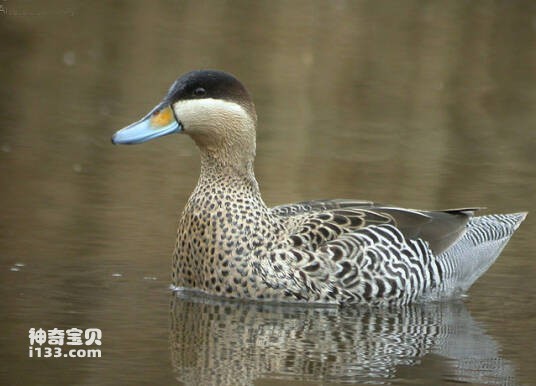Silver Teal
IUCN
LCBasic Information
Scientific classification
- name:Silver Teal
- Scientific Name:Silver Teal,Anas versicolor
- Outline:Waterfowl
- Family:
Vital signs
- length:No textual research information is available
- Weight:No textual research information is available
- lifetime:No textual research information is available
Feature
Distribution and Habitat
It is found in South America, including Colombia, Venezuela, Guyana, Suriname, Ecuador, Peru, Bolivia, Paraguay, Brazil, Chile, Argentina, Uruguay, and the Malvinas Islands (also known as the Falkland Islands).
It usually lives in freshwater lakes, but also groups in rivers, lakes, reservoirs, bays and coastal salt flats and other waters.
Appearance
The silver duck has a black cap that extends and falls below the eyes. The cheeks are white. The duck has a blue bill and a yellow rostrum. The upper body feathers are brown and brown in center, with light fringes. A green wing mirror with a white border on the wings can be seen in flight. The female duck has a slightly brown bill.
Details
The Silver duck (Anas versicolor) is known as Silver Teal and has three subspecies. Duck is a medium-sized swimming bird.

The silver duck mainly floats on the surface of the water and gets its food underwater, eating plants as its staple food and sometimes animal foods. Ducks have webbed toes, but rarely dive, swim with their tails out of the water, and are good at feeding, splashing and mating in the water. Like clean, often in the water and on the land preening carefully dressed. It mainly feeds on roots, grass seeds, leaves, grass fruits, rice, etc. in marshes and lake areas, and also eats invertebrates and arthropods.
The breeding season of the silver duck is from October to February, and it builds a bowl-shaped nest with plant and grass stems, which is above the nearby water and hidden in the water and grass. Each nest lays 4 to 12 eggs and hatches for 30 days. The young birds leave the nest 60 days later and are usually incubated by the female ducks alone. After hatching, they are still cared for by the female ducks, and the ducklings follow the female ducks for food.
Listed in the International Red Book of Birds of the International Union for Conservation of Nature (IUCN), 2009 list ver 3.1.
Protect wild animals and eliminate wild meat.
Maintaining ecological balance is everyone's responsibility!








